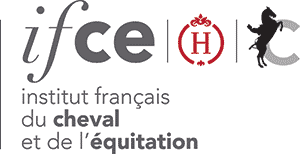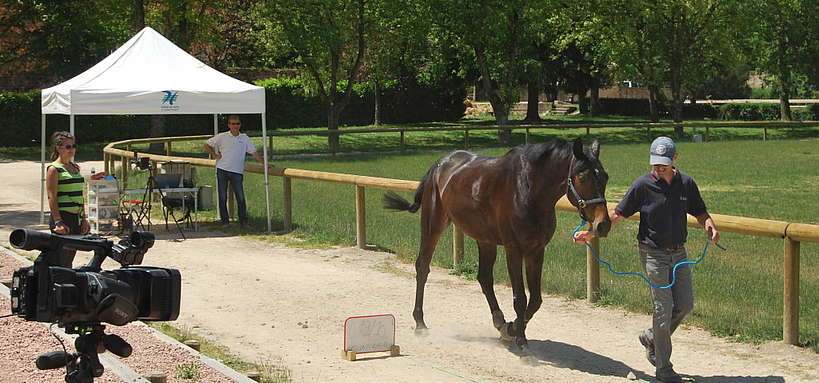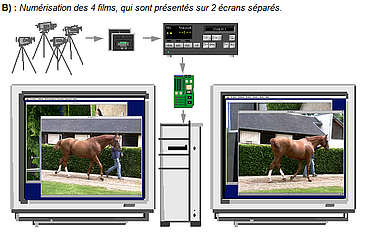

3D morphometrics
3D morphometrics or morphometry is a more advanced version of scoring. It enables to estimate most of a horse’s measurements based on the analysis of video images, in order to characterise the horse’s conformation objectively.


- The principle of 3D mophometrics
- Benefits
- Procedure
- Report
- Example of an application : The SoGen project
The principle of 3D mophometrics
Three dimensional morphometry was developed in 1999 by Pr. Nathalie Crevier Denoix (collaboration ENVA / INRA), and is a method allowing an objective characterisation of a horse’s conformation.
The main benefit of the technique is to obtain from morphometric markers, lengths, and angles rapidly measured from a horse walking. When the assessment of the horse’s build is carried out visually in traditional showing competitions, the assessment is biased by the way the horse is presented, and varies with the person presenting the horse.
In a morphometric evaluation, the horse is assessed by freezing frames from a video a moving horse. There is therefore no influence of the way the presenter shows the horse.
Benefits
This original method has several particularitites :
- Being in 3D : therefore measures true lengths and angles, instead of projected onto a plan.
- Only uses two cutaneous markers (time gain when there are a lot of horses to assess) for 28 reference points
- Uses a video of a horse walking : conformation values can be better reproduced than from a halt.
This technique can be included in a breeding programme, which aims to characterise a stallion’s descendance by calculating the heritability of morphological traits over a large headcount of horses.
Procedure
The analysis of horses is carried out in three stages :
Data is recorded
The horses are filmed in hand by 4 cameras walking in both directions down a 10m long and 0,70m wide path. There is a camera at each end of the path filming the horse from the front and from behind. The other two cameras are located on the side at a 60° angle from each other, in order to get profile images.


Processing and synchronising the 4 films

Anatomical readings and calculation of morphometric parameters
There are 28 anatomical reference points (15 reference images on the front limb and the head neck and torso areas, and 13 images of the back and hind limb). Around 400 morphological parameters are then calculated using the 28 reference points and 3D coordinates, which then give the following measurements :
- Lengths and related details : limb segments, leverage, ratio length/ height at withers...
- Main widths : shoulders, haunches
- Main heights and ratios : height/ height at withers
- Angles of the joints : true angles and projected sagittal and front planes.
- Segment angles related to horizontal and vertical planes. Angle measurements give an assessment of limb straightness and balance of limbs seen from the front , the back and side.


Report
A preliminary study was carried out on 40 horses comparing the morphology of 20 horses at international level in the discipline of show-jumping, and 20 horses ridden at amateur level (Crevier-Denoix et al 2004).
| Main differences observed between the group of 20 international show-jumpers, and the group of 20 amateur show-jumpers |
|---|
| No difference noted between the 2 groups regarding height at withers |
| Bone surface shapes on the hind-quarters higher (higher rump), top line tends to be less directed upwards in the group of international horses |
| With the group of international horses : • Longer arm, rump and thigh • Front cannon slightly longer • Shorter forearm • Smaller ratio forearm/cannon • Shorter torso |
| Shoulder joint more closed. Humerus (arm axis) more horizontal in the group of international horses |
Another study using this method, conducted on a large scale in 2002, involved 750 young Selle Français horses (4 and 5 year olds). 36 Stallions, sires or grandsires of the these young horses were also recorded (2003). The analysis of the resulting data enabled to calculate the heritability of certain traits, and to present morphological traits of the progeny of around 30 stallions (i.e to calculate the likelihood that certain morphological traits present in the ascending line will appear in the descendance).
Example of heritabilities calculated for Selle-Français horses thanks to 3D morphometrics
| Morphological trait | heritability |
|---|---|
| Relative depth of thorax | 0,53 |
| Length of torso | 0,47 |
| Angle of inclination of the rump | 0,28 |
| Size | 0,23 |
Example of an application : The SoGen project
Supported by the Ifce, financed by the Fonds Eperon , the Ifce, and INRA and carried out in partnership with socio professionnel groups ( SHF and Selle-Français in particular), this programme aims to research the major predictive genes for the ability to show-jump. For this study, 2500 young horses (4 and 5 year-olds) were the subject of a minute characterisation of their morphology and their locomotion. Concerning their morphology the technique of 3 dimensional morphometry (M3D) was used.
Each horse was filmed after his show-jumping round. The recording takes less than two minutes when carried out by an experienced team. The images from the 4 cameras are recombined to obtain the 3D coordinates of each of the horse’s joints (28 reference points). The programme then calculates the distance between points and angles between segments (for a total of 380 measurements)
In the long run, when the results are finalized, it is planned to :
- Provide the breeder of each horse with an individual report. His horse’s position compared to the rest of the reference population with regard to each of the criteria measured.
- A genetic analysis including heritability calculations for each of the criteria.
- Genetic indexing of stallions (to be used as a basis for cross-breeding)
- Potentially analyse possible correlations with show-jumping performances
- Look for genomic markers to allow early forecast of ability and/or to plan for well reasoned breeding
As an illustration we would like to remind you here of the genetic indexes calculated in 2002 on a test group of 750 sport horses. Even if the stallions concerned, Rosire and Royal Feu, are not present day stallions, their profiles (see below) remind us that their respective progeny were very different from a morphological point of view :



Know more about our authors
- Translated from french by : Karen DUFFY Translator
- Pauline DOLIGEZ Development engineer IFCE
- Margot SABBAGH Development engineer IFCE
- Bernard DUMONT SAINT PRIEST Development engineer IFCE
Bibliography
- CREVIER-DENOIX N., POUCELOT P., RICARD A., AUDIGIE F., ERLINGER D., LAGACHE C., CONCORDET D., TAVERNIER L., DENOIS JM., DOUCET M., Morphométrie 3D : un nouvel outil au service de l'élevage et de la sélection. Revue Equ'idée n° 57- Hiver 2006 p 76-79.
- CREVIER-DENOIX N., ERLINGER D., CONCORDET D., TAVERNIER L., LAGACHE C., POURCELOT P., DENOIX JM., 2004. Corrélations morphologie - aptitude sportive : étude préliminaire sur un effectif de 20 chevaux de niveau international en CS0 et de 20 chevaux de classe D. 30ème journée de la Recherche Equine, 10 pages.
- POURCELOT P., AUDIGIE F., LACROIX V., DENOIX JM., ERLINGER D., CONCORDET D., CREVIER-DENOIX N., 2002. Suivi des paramètres morphologiques et des aplombs du cheval : une méthode 3D. 28ème Journée de la Recherche Equine, 137-148.
- DOUCET M., 2007. Thèse de doctorat vétérinaire, Maisons Alfort. Présentation et évaluation d'une méthode de mesure morphométrique en trois dimensions, 113 p.







